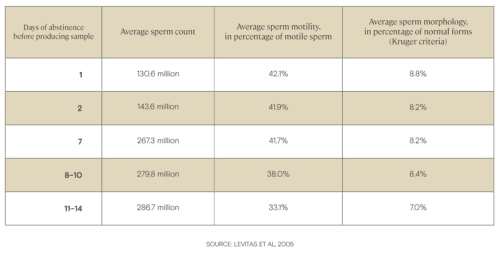If there’s one thing you’ll be doing a lot of when you’re trying to conceive, it’s sex. For many couples, it can take up to six months of regular, timed intercourse to get pregnant. That’s a good amount of time spent in the bedroom.
With everything else you have to think about while you and your partner are trying to conceive—ovulation timing, improving your sperm, and planning for a baby—there’s no reason for sex to be another stressor. Here are the 4 most common myths about sex and fertility, and what the science really says.
Myth: “Specific sex positions can increase your chances of pregnancy.”
Truth: Any position can result in pregnancy, so do it in whatever way works best for you.
While it’s not illogical to think that your sex position might affect conception, according to the American Society for Reproductive Medicine, there’s “no evidence that coital position affects fecundability.” In other words, there’s no scientific backing to the idea that having sex in missionary, reverse cowgirl, or any other orientation will increase your chances of getting pregnant.
Another similar myth: The idea that your sex position during conception can impact whether you have a boy or a girl—also not based in science. The baby’s biological sex is determined by whether or not the sperm that ultimately fertilizes the egg carries an “XX” or an “XY” chromosome, and nothing you do between the sheets is going to change that.

The bottom line here is that how you have sex isn’t going to affect your chances of pregnancy, so you should simply focus on doing it in a way that feels good for you and your partner. Having sex on a schedule can eventually feel like a chore, so it’s important to do whatever you can to keep having fun and feeling connected to each other.
Myth: “If she has an orgasm, there’s a better chance she’ll get pregnant.”
Truth: This isn’t evidence-based, so don’t stress out about it—but it can’t hurt to prioritize your partner’s pleasure.
The idea that the female orgasm aids in conception has only ever been hypothetical. It’s based on the fact that an orgasm typically involves pelvic contractions, which—in theory—can help “pull” the sperm from the vagina up through the cervix and into the uterus. This has been presented by some biologists as the “evolutionary” explanation for the female orgasm.
A fine theory, but it isn’t supported by the scientific evidence. A study of over 8,000 women found no correlation between how many orgasms they’ve had and how many children they had. So, it’s unlikely that the female orgasm fulfills this “function,” or that it’s imperative to fertility.
This should relieve a little stress on couples who are trying to conceive; it doesn’t need to be the best sex you’ve ever had, every time, in order to make a baby. That may not even be realistic when you’re doing it every other day. But, again, it’s really important that you don’t lose sight of your desire for your partner and what makes you both feel good.
Myth: “‘Saving up’ sperm before sex can increase your chances of conception.”
Truth: Sperm quality decreases after 2–5 days of abstinence, so long periods between ejaculation isn’t necessarily beneficial.
It may seem counterintuitive, but “saving up” your sperm could actually decrease your chances of conception. Sperm are created every day, and once they’re mature, they’re stored in the epididymis, a coiled tube behind each testicle, until ejaculation. As they wait, their health diminishes pretty quickly—the DNA inside the sperm accumulates damage and the sperm themselves become less motile.

So, while sperm count increases with the length of your abstinence, your sperm quality actually decreases after about 2–5 days of abstinence. That’s why it’s recommended that, if you have a normal sperm count, you have sex every 1–2 days during your partner’s fertile window (the 5 days leading up to ovulation) to optimize your chances of pregnancy.
Men with a low sperm count, on the other hand, will actually want to have sex more often—every day or even multiple times a day—to increase the total number of sperm that have the possibility of fertilizing the egg. Learn more about abstinence and sperm quality.
Myth: “Morning sex is most likely to result in pregnancy.”
Truth: Sperm counts may be slightly higher in the morning, but there’s not enough evidence to change your sex routine.
The research on what’s known as “diurnal,” or daily, changes in sperm count and quality is far from conclusive. One large-scale study (over 12,000 semen samples from 7,000 men experiencing subfertility) concluded that semen samples collected in the early morning, before 7:30am, had the highest sperm count and sperm quality.
But another, much smaller study of 54 men found the exact opposite result: sperm count and motility were higher in the afternoon, between 5 and 5:30pm, compared to between 7 and 7:30am. Similarly, a study of sperm DNA fragmentation found that the percentage of sperm with DNA damage decreased in samples produced after 7am.
So, in the absence of clear evidence one way or another, we’ll just repeat ourselves: Sex at any time of the day during your partner’s fertile period can result in pregnancy. If morning sex is your thing, do it in the morning. If you prefer a midnight romp, that works too.